 |
| “Won’t somebody please think of the children?!” |
 |
| The Mother of Dragons, Daenerys the Unburnt |
 |
| Brienne hears Jaime’s tale of killing the Mad King |
The radical notion that women like good movies
 |
| “Won’t somebody please think of the children?!” |
 |
| The Mother of Dragons, Daenerys the Unburnt |
 |
| Brienne hears Jaime’s tale of killing the Mad King |
In fact, the difference between gratuitous nudity and artistic nudity is not that difficult to discern. Even ‘Game of Thrones,’ the show that puts the word “tit” in “titillation,” occasionally uses nudity in a way that isn’t exploitative and adds to a scene rather than detracting from it.
 |
| “Won’t somebody please think of the children?!” |
 |
| The Mother of Dragons, Daenerys the Unburnt |
 |
| Brienne hears Jaime’s tale of killing the Mad King |
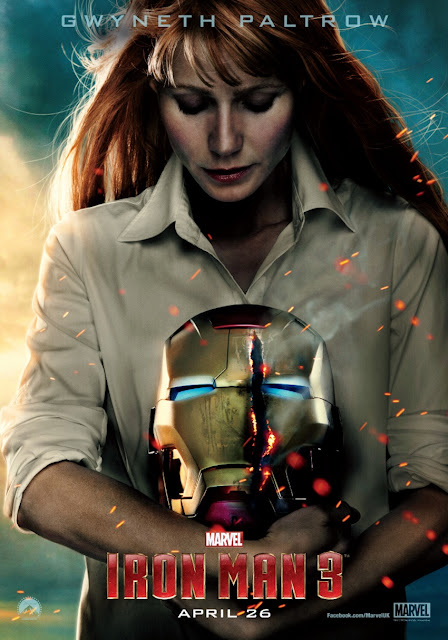 |
| Movie poster for Iron Man 3 |
Written by Megan Kearns | Warning: Lots of spoilers ahead!
Superhero films often exhibit assertive, outspoken female characters. Yet they often simultaneously objectify women’s bodies, reduce them to ancillary love interests or perpetuate gender stereotypes. So when I heard that Pepper Potts would have a more active role in Iron Man 3, I was excited yet remained cautiously skeptical.
“I was really hoping that Pepper would be more engaged in this movie…So I was really happy, not only that she was wearing the suit, but that you see her really on equal ground with Tony in their interpersonal dynamic, and as a CEO, and then she’s got all this action… I think in order to move things forward and keep it fresh, you can only be the damsel in distress for so long, and then it’s old.”
 |
| Tony Stark |
Just because Pepper donned the Iron Man suit for like two minutes, doesn’t mean she isn’t a “damsel in distress.” She still is for a majority of the film. Archvillian Aldrich Killian kidnaps Pepper and ties her up, using her as bait to lure Tony and blackmail him. Yep, that sounds like a passive damsel to me.
“So the damsel trope typically makes men the “subject” of the narratives while relegating women to the “object.” This is a form of objectification because as objects, damsel’ed women are being acted upon, most often becoming or reduced to a prize to be won, a treasure to be found or a goal to be achieved…The damsel in distress is not just a synonym for “weak,” instead it works by ripping away the power from female characters, even helpful or seemingly capable ones. No matter what we are told about their magical abilities, skills or strengths they are still ultimately captured or otherwise incapacitated and then must wait for rescue. Distilled down to its essence, the plot device works by trading the disempowerment of female characters FOR the empowerment of male characters.”
Surprisingly, as it revolves around Tony, Iron Man 3 passes the Bechdel Test. Huzzah! A brief conversation transpires between Pepper and Maya, the botanist who invented the Extremis virus. Maya laments being naïve about science, just wanting to help people and how her ideals became distorted. Pepper reassures her, telling her that Stark Industries once carried out military contracts so she shouldn’t be so hard on herself. What a nice moment. But don’t get too cozy. This moment of sisterly bonding shatters when Maya betrays Pepper. Sidebar, it’s interesting that Maya has a change of heart not after talking to Pepper but after talking to Tony later in the film.
 |
| Gwyneth Paltrow in the Iron Man suit |
It’s a strange juxtaposition between “she’s perfect the way she is” and “I’ll fix you,” especially in proximity to one another. This dialogue could have easily been altered to show Pepper’s agency — that either she wanted to keep the virus and harness the superpower or have it removed. We could have seen things from her perspective. But instead, it’s all to convey how Tony is decisive and protective of his woman and how he’s grown emotionally.
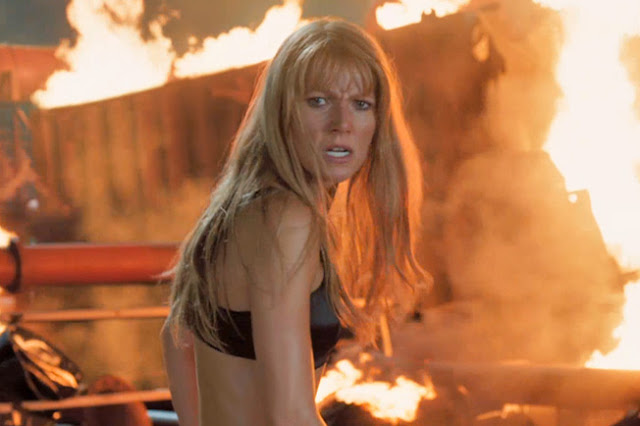 |
| Gwyneth Paltrow as Pepper Potts in Iron Man 3 |
The problem with the Damsel in Distress trope is that it strips women of their power and insinuates that women need men to rescue or save them. And yet again it places the focus on men, reinforcing the notion that society revolves around men, not women.
While many women orchestrate machinations behind the scenes, no woman is openly a leader, boldly challenging patriarchy to rule. Except for one. Daenerys Stormborn of House Targaryen.
 |
| Emilia Clarke as Daenerys in Game of Thrones |
Written by Megan Kearns for our Infertility, Miscarriage and Infant Loss Week. | Warning: Spoilers ahead!
When I first wrote about Game of Thrones two years ago, I wrote about its vacillation between showcasing strong, intelligent female characters and its sexist objectification and misogynistic rape culture.
I received an exorbitant amount of comments on my criticism of the show — even though I simultaneously lauded its brilliant acting and interesting characters and dialogue. Some told me I didn’t understand anything about the show. Others told me to wait, just wait as it would get better. While the show suffers serious problems, particularly in its sexposition and depiction of graphic female nudity, as the show has progressed, it has indeed become more and more feminist.
We witness more of the women expressing their disdain for their lot in life due to their gender. We see women buck gender norms (Arya, Brienne, Yara Greyjoy) and we see women scheme to surreptitiously assert their power (Margaery Tyrell, Cersei Lannister, Olenna Redwyne) or even just to better their lot in life (Shae, Ros, Sansa).
While many women orchestrate machinations behind the scenes, no woman is openly a leader, boldly challenging patriarchy to rule. Except for one. Daenerys Stormborn of House Targaryen.
When I first wrote about Dany (Emilia Clarke), I was captivated by her. She drew me in immediately and became my favorite character. I loved watching her transformation from meek and timid, bullied by her creepy brother Viserys, to a powerful yet kind-hearted Khaleesi (Queen). Each episode she grows more bold and assertive. Yet she continually strives to be fair and just. Watching her growth has been the most enjoyable aspect of the series.
Daenerys marries Khal Drogo in an arranged marriage in order to secure Viserys, rightful heir to the Iron Throne after the murder of their father the king, an army so he can claim the throne. Viserys uses Dany, telling her he would have all 40,000 Dothraki rape her if it garnered him an army. Nice guy.
After a rapey wedding night (Sorrynotsorry, fans. It is), Daenerys and Drogo eventually form a bond and fall in love with one another. (I know, I know, but bare with me). Dany grows more confident and assertive both with her sexuality and her authoritativeness in giving the khalasar (clan or tribe) commands. Months later, when Viserys hits her, she hits him back and tells him if he strikes her again, she will have his hands cut off.
When Dany becomes pregnant with a son, she eventually convinces her husband to cross the sea, something the Dothraki fear, in order to claim the Iron Throne and rule. Both Daenerys and Drogo believe their son Rhaego will be the heir to the throne, calling him the “Stallion Who Mounts the World,” because according to a Dothraki prophecy he will be a great khal (king) of khals, uniting the Dothraki as one khalasar (clan or tribe) and conquer the world.
 |
| Game of Thrones |
After Khal Drogo’s khalasar conquer a village, Daenerys — growing more confident and outspoken — prevents the men from raping the enslaved women. When challenged by her husband, she boldly defends her decision, trying to advocate for the women’s rights. Rather than crediting his wife’s penchant for advocacy, Drogo tells her she grows fierce as their son grows in her womb, “filling her with fire.”
But after her husband has a wound, Mirri Maz Duur an enslaved shaman whose life Dany spares, treats his injury. Yet he falls deathly ill. Mirri tells Dany how to save him, by using blood magic, something forbidden by the Dothraki. Dany follows her instructions. Yet she goes into labor and passes out. When Dany awakens, her advisor Jorah tells her that her son was born dead and deformed with scales. She’s been “rewarded” by having Drogo a shell of his former self in a catatonic state. When Dany confronts the shaman, asking when she will be reunited with her husband, Mirri replies:
“When the sun rises in the west and sets in the east. When the seas go dry and mountains blow in the wind like leaves. When your womb quickens again, and you bear a living child. Then he will return, and not before.”
Mirri’s spell took the life of Daenerys’ unborn son as revenge for the Dothraki attack on her village. Also inherent is an infertility curse, that Dany will not have any of her own children. She loses the lives of both her husband and her unborn child.
With nothing left to lose, Daenerys resolves to make a bold and drastic decision which showcases her resolve and empowerment. As Angela Smith wrote on bereaved mothers at Bitch Flicks:
“It’s not uncommon for women to feel empowered to make drastic changes after losing a child. They may, understandably, become far less tolerant of others due to the realization nobody at all can break them down any further than they’ve already been broken.”
Dany has one of her Khalasaar place 3 dragon eggs she was given as a wedding present on the pyre. As the fire burns, she steps into the flames, despite the protestations of Jorah. In the morning, a new day has dawned. Dany emerges from the ashes unharmed, and the eggs have hatched with the 3 dragons perched on her body.
 |
| Daenerys becomes the Mother of Dragons |
But now that she has lost her son, Daenerys decides she will take the Iron Throne herself and rule the Seven Kingdoms. After all the men in her life — her husband, son and brother — have died, she claims the throne for her own.
Dany becomes the metaphorical phoenix rising from the ashes, purging the last vestiges of her former timidity to transition into her life as a powerful leader.
At the end of season one, I’ll admit I worried that her magical powers were somehow explaining away her awesomeness. But now I see that no, it’s merely to highlight the importance of her role in Game of Thrones — as a woman leader challenging sexism.
Daenerys is continually called the Mother of Dragons, spoken with awe and reverence. In many cases, women are allowed to lead or be ruthless as lioness mothers. And while Dany lost her son, and she may be cursed with infertility by Mirri, she still remains a mother figure. She envisions herself as the mother to her 3 dragons. In the second season’s episode “Prince of Winterfell,” Dany’s dragons are kidnapped in the city of Qarth. When Jorah tells her to abandon them, that they are not her children, and escape, Dany replies:
“A mother does not flee without her children…They are my children, and they are the only children I will everhave.”
Daenerys risks her life to save her dragons, and they save her life and free her when she’s captured as well. The mysterious masked woman Quaithe tells Jorah that “dragons are fire made flesh…and fire is power.” Daenerys has given birth to power. Power contains a duality – it can subjugate and torment or it can crush oppression and yield justice.
Speaking with confident assuredness, Daenerys tells those that doubt her:
“When my dragons are grown, we will take back what was stolen from me and destroy those who have wronged me! We will lay waste to armies and burn cities to the ground!…I will take what is mine, with fire and blood!”
In season 3, after having survived the treacheries in the city of Qarth, Daenerys looks to procure an army in the city of Astapor in order to take the Iron Throne. Despite her steeliness, she has not lost her kindness. She tries to give water to a dying slave. She doesn’t hide her horror and disgust during negotiations when she hears that murdering a newborn in front of the infant’s mother is a component of the training for the highly skilled slave warriors, the Unsullied. To her advisors, she expresses her unease over buying slaves for an army. She doesn’t want the “blood of innocents” on her hands.
 |
| Daenerys with advisors Ser Jorah Mormont and Ser Barristan Selmy |
In last week’s episode “And Now His Watch Is Ended,” Game of Thrones turned a corner in perhaps the most feminist episode of the series.
Daenerys makes a trade for all 8,000 Unsullied warriors, appearing as if she’s going to give up her dragon Drogon to make the exchange. But it’s all a ruse. When the brutal slaver Kraznys — who has insulted Dany with sexist, slut-shaming insults, erroneously thinking she didn’t understand the Valeryian language — is irritated that her dragon doesn’t obey him, she retorts that of course he doesn’t, “a dragon is a not a slave.” Dany then orders the Unsullied, now in her command, to murder the slavers and break the chains off the slaves. She frees the enslaved warriors, asking them to fight for her as free men. Daenerys then drops the whip equating ownership of the slaves. In essence, she drops the symbolic weapon of tyranny and oppression, heralding rebellion.
If there was ever any question, Daenerys is clearly here to dismantle the patriarchy.
Not only is she a woman leader, her very existence challenging the status quo. But Daenerys openly questions and challenges patriarchal norms. She refuses to abide by societal gender limitations mandating men must rule. She’s determined to forge a different path. Rather than follow in the footsteps of leaders embodying toxic masculinity, she’s determined to rule through respect, kindness and fairness — not through intimidation or fear. Daenerys refuses to enslave people. She wants to emancipate them.
The Mother of Dragons cares for the dragons as if they were her own babies. Could it be that Daenerys will become the archetypal mother of humanity? Perhaps. She’s wielding justice, crushing oppression and protecting the weak. Yet it is the loss of her son that enables Daenerys to envision herself in the role of leader. No longer is she supporting a man to be a great leader. She has become that leader.
The princess has become a queen.
 |
| Dany being a badass. Boom. |
 |
| House of Cards poster |
Written by Amanda Rodriguez
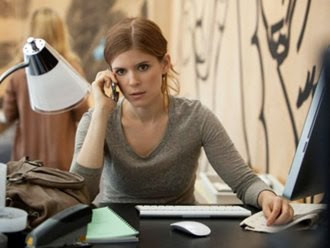 |
| “Okay, so you think when a woman asks to be treated with respect, that’s arrogance?” – Zoe Barnes |
 |
| “Tough as a two dollar steak.” – Frank Underwood of Linda Vasquez…too bad she’s not actually Latina |
 |
| “I won’t let people like you fuck up the world my child has to live in [even] if I have to tell a few lies…” – Gillian Cole to Claire Underwood |
 |
| Janine Skorsky in House of Cards |
 |
| “No, I’m not going to ask for your blessing on every decision I make.” – Claire Underwood to Frank Underwood |
One of the first meaningful interactions we get with Claire is when she fires 18 staff members in order to create a new water well building project while not taking donations from SanCorp, a source that would indebt her husband for political favors. She has Evelyn Baxter, her office manager, do the dirty work, and then Claire proceeds to fire Evelyn because she was vocal in her concerns about the mass layoffs. The impression this gives us of Claire is that she is cold, calculating, and completely intractable. More than a match for her husband, the master manipulator Frank, Claire is willing to do whatever it takes to achieve her goals, regardless of whether she must apply her cutthroat ambition to a philanthropic enterprise like well building.
 |
| “I love that woman. I love her more than sharks love blood.” – Frank Underwood of Claire Underwood |
Though the layoffs at her job set Claire up as the restrained, soft-spoken, heartless “ice queen,” we later find that these sorts of sacrifices actually affect her deeply when she uses her status as Frank’s only completely trusted ally in order to sabotage his education bill for her own gains. After repeatedly asking for her husband’s help with finances and influence (because his political aspirations have grievously limited those things for her organization) and after repeatedly being rebuffed and ignored by him, Claire, as a favor to Frank, agrees to speak to a couple of representatives who are leaning against voting for his education bill. By intentionally not swaying these votes, Claire causes the bill to fail and therefore secures the necessary influence with the Sudanese government she needs to begin her well building project. When Frank confronts her, we see Claire’s most impassioned response of the entire season:
“[I did it] For myself. I can’t operate based on plans you haven’t shared with me…I don’t feel as though I’m standing beside you…I fired half of my staff for us. I have turned down donations for us. I drafted Peter’s bill for us. I diverted time and energy…for us…Be honest about how you’re using me just like you use everyone else. That was not part of the bargain.”
Claire asserts that Frank hasn’t behaved in keeping with their agreement, their partnership. She makes it clear that she will not allow him to take advantage of her and that if they’re not working as a unit, she will take matters into her own hands to meet her needs and objectives. Claire then proceeds to leave town to visit with a former lover of hers, thus also meeting the emotional needs that Frank has neglected. Her independence and her unwillingness to tolerate Frank’s complacency here are admirable.
 |
| The imperious Claire Underwood |
The marriage between Claire and Frank is also unique. Claire recounts Frank’s marriage proposal:
“Claire, if all you want is happiness say no. I’m not going to give you a couple of kids and count the days until retirement. I promise you freedom from that, I promise you’ll never be bored…He was the only one who understood me. He didn’t put me on some pedestal, he knew that I didn’t want to be adored or coddled.”
They have a very open, autonomous, conspiratorial relationship wherein they sleep with other people and keep no secrets from each other. I do question the fact that Claire’s affair with Adam has genuine depth and substance, while Frank’s affair with Zoe is a blatant cliche replete with the middle-aged married man sleeping with the young ingenue, the power dynamics grossly skewed (though even that tryst ends up taking us into surprising places). The two affairs are in keeping with the notion that men can have casual sex and women cannot because they require an emotional connection.
I also question Claire’s rising desire to have children. Is this budding maternal instinct meant to humanize her? The idea that she had always wanted children but repressed her desires to accommodate Frank’s hatred of children is not at all in keeping with her character. Since when does she relegate her wants to the backseat, especially for decades? I do, however, appreciate the continued independence that she shows in this regard, seeking fertility treatments without Frank’s knowledge because he has failed her as a partner. Not only that, but the pregnancy itself could be a strategic play to thwart Gillian’s lawsuit for wrongful termination due to pregnancy discrimination; the logic being: how could one pregnant woman wrongfully fire another pregnant woman due to her pregnancy?
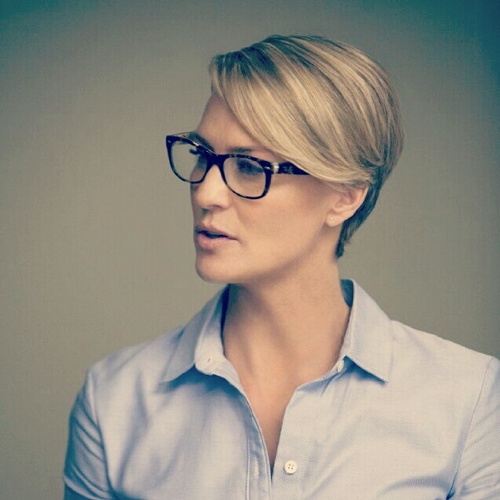 |
| Claire Underwood in House of Cards |
There’s no denying that despite her highly suspect morality, Claire Underwood is an extraordinarily powerful woman. Her power stems from a confidence in her capability, her intelligence, and her ambition. Claire has power because she knows she has power. She has power because she’s taken it and guards it fiercely. Is she a decent person? Absolutely not. Is she a feminist role model? Probably not. But representations of nuanced powerful female characters are in short supply in Hollywood. I’d love to see more women (on screen and off) with Claire’s sense of her own strength and self-worth. Let’s hope Netflix is onto something, and keep our fingers crossed that House of Cards Season 2 is just as rich with complex women as its first season was.
Yes, ‘Game of Thrones’ is a show that loves its nudity. HBO is known for gratuitous displays of naked ladies in many of its show, but ‘Game of Thrones’ might as well exist on a network called HBOOB.
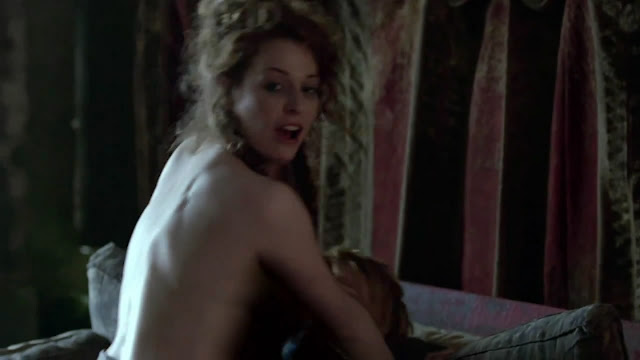 |
| Ros from Game of Thrones. Full frontal nudity in 3… 2… 1… |
 |
| Doreah: not nude in this scene, but give her a minute |
“A frustrated Weiss responded to a question about the amount of sex and nudity on the show, and the commentary about it, by saying, ‘We put in the show what we think belongs in the show. There are going to be people who think there’s too much of something, or not enough. If you create a show with a committee of a million people, you’re not going to make a very good show. We do what’s right to us.'”
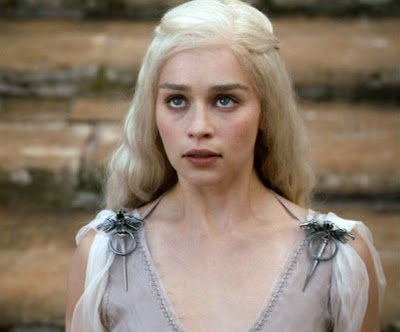 |
| Daenerys Targaryen, between one nude scene and another |
———-
 |
| Ros from Game of Thrones. Full frontal nudity in 3… 2… 1… |
 |
| Doreah: not nude in this scene, but give her a minute |
“A frustrated Weiss responded to a question about the amount of sex and nudity on the show, and the commentary about it, by saying, ‘We put in the show what we think belongs in the show. There are going to be people who think there’s too much of something, or not enough. If you create a show with a committee of a million people, you’re not going to make a very good show. We do what’s right to us.'”
 |
| Daenerys Targaryen, between one nude scene and another |
———-
 |
| Quvenzhane Wallis as Hushpuppy in Beasts of the Southern Wild |
Guest post written by Laura A. Shamas, Ph.D.
Later, the water serves as a source for spiritual cleansing; Hushpuppy embarks on a search for her mother, and finds maternal nurturing from women who work aboard a pleasure ship, the “Elysian Fields Floating Catfish Shack” featuring “Girls Girls Girls.” Wink’s passing, with final ship burial rites that are similar to those of the ancient Vikings, is connected to a spiritual return to the sea.
The theme of “regeneration” is clear in the ending of Beasts of the Southern Wild, and discussed in further detail below. Much more than a mere setting, water is part of every major plot turn, and somehow young Hushpuppy must learn to live with it, on it, and sail through it.
 |
| Beasts of the Southern Wild |
Classic tales from traditions worldwide feature flood motifs. The Sumerian Epic of Atrahasis predates Noah’s story; ARAS’ The Book of Symbols says the Atrahasis tale “describes casualties of flood strewn about the river like dragonflies.” [vi]
The familiar story of Noah’s Ark is one of many legends in which the deluge brings a renewal, the start of a new cycle, even a rainbow. In the Gilgamesh Flood Myth (which some scholars trace to The Epic of Atrahasis), Upnatishtim must build a boat to weather a storm so foul its verocity frightens the very gods who created it. Like Noah, Upnatishtim’s boat eventually lands atop a mountain.
In the Irish legend of Fintan mac Bóchra, Fintan escorted one of Noah’s granddaughters to Ireland. As one of three who lived through the deluge, Fintan “the Wise” survived the deluge by shape-shifting into a salmon and two birds; eventually he became a human again and advised the ancient Kings of Ireland. A Kikuyu story (Kenya) tells of spirits drowning a town with beer, as inhabitants find refuge in a tavern.
In China, the tales of “Yu The Great” center on flood fighting, with family sacrifices as part of the battles, and supernatural assistance in the form of a yellow dragon, or in some versions, Yu is the dragon. [vii] An ark features prominently in the Greek myth of Deucalion and Pyrrha, Prometheus’ son and Pandora’s daughter, who survive a flood unleashed by Zeus. Floods are also featured in numerous Native American tales, such as the Arapaho story of Creation, in which a man with a Flat Pipe enlists Turtle to help save the land or the Chickasaw Nation’s Legend of the Flood in which a raven delivers part of an ear of corn to a lone remaining family on a raft, post-Deluge.
 |
| Hushpuppy faces an Auroch in Beasts of the Southern Wild |
In Beasts of the Southern Wild, the melting ice cap imagery is linked to the global warming rise of coastal waters — perhaps Earth’s way of punishing humankind (which could be seen as divine chastisement related to myths above). The “watery end of the world” theme, the motorboat as ark, the tavern as place of refuge, the release of supernatural beings (such as Hushpuppy’s vision of the frozen Aurochs unleashed through global warming), the connection to animals and earth as agents of healing (Hushpuppy listens to them): all of these elements in the film may be seen as related to flood myth tropes. Although there is no rainbow at the end, there is definitely as sense of renewal as Hushpuppy becomes the new Bathtub leader. The imagery and mythic tropes in the film overall resonate with symbols of giving birth: from the womb-like ark, to overwhelming water which could be seen as related to amniotic fluid, through Hushpuppy’s search for her long-absent mother.
With our collective experience of Hurricane Katrina in 2005 and now Sandy in 2012, the poignant depiction of flood mythology tropes resonate strongly in this award-winning film. Watching Beasts of the Southern Wild allows us to consider the Deluge’s symbolic import to the human psyche not only as an image of destruction, but as an important signal of change, marking a time of transformation.
Guest post written by Natalie Wilson, originally published at Ms. Magazine. Cross-posted with permission.
Got a thing for zombies? Have some tween-age children in your life? Do you like whizz-bang stop-motion animation? Or, perhaps you are one of those types who appreciates a well-developed cast of characters that kicks stereotypes to the curb, features strong women and – can it be true?!?! – has a positively depicted openly gay character. If so, get thee to a theater and see the little-buzzed-about but much deserving ParaNorman–a zombie film not only with brains but a lot of heart.
 |
| Norman Babcock and his family in ParaNorman | (L-R): Grandma Babcock (Elaine Stritch), Sandra (Leslie Mann), Perry (Jeff Garlin), Norman (Kodi Smit-McPhee), Courtney (Anna Kendrick) |
 |
| Neil (Tucker Albrizzi) and Salma (Hanna Noyes) in ParaNorman |
“You may be wondering why Maya — so stoic and static throughout her years of hunting — breaks down into sobs when the mission is over… All this comes after a decade of ruthless pursuit, in a career to which she has sacrificed her entire life and, for the audience, more than two hours of watching a character display no hint of an emotion other than vengefulness, dedication, patriotism or anger.”
 |
| Jessica Chastain as Maya in Zero Dark Thirty |
 |
| The Vamps DVD cover |
 |
| I fucking so instagrammed this |
This is a guest post by Jessica Freeman-Slade.
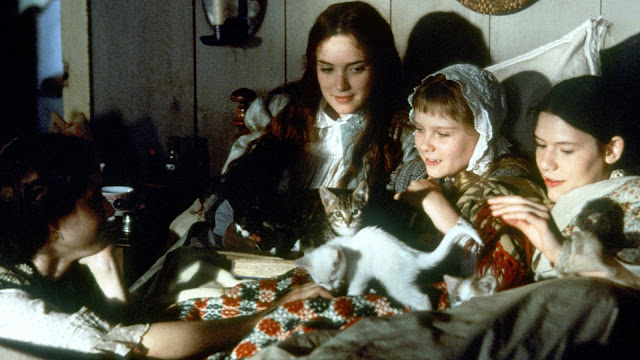 |
| March girls in bed |
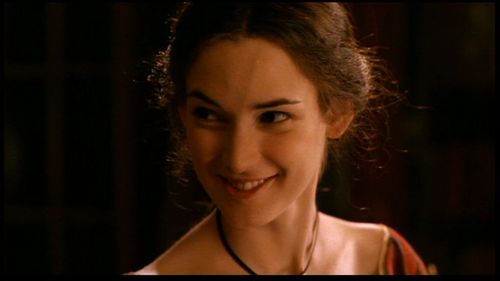 |
| Winona Ryder as Jo |
 |
| Laurie (Christian Bale) and Jo |
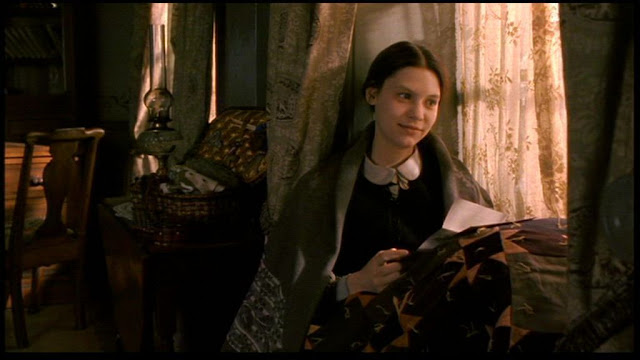 |
| Claire Danes as Beth |
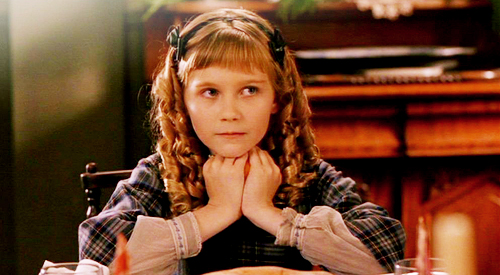 |
| Kirsten Dunst as Amy |
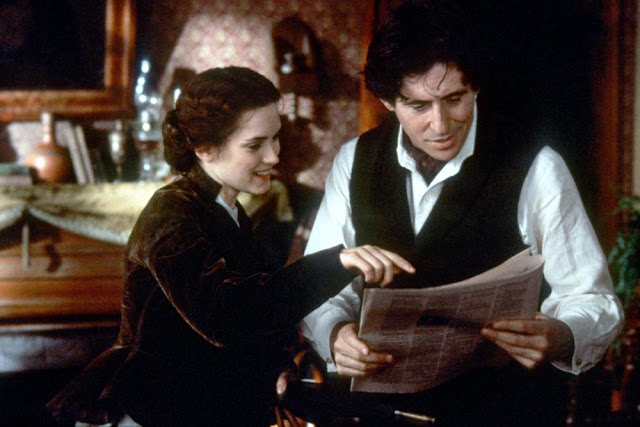 |
| Jo and Bhaer (Gabriel Byrne) |
 |
| Meg played by Trini Alvarado |
Marmee: Nothing provokes speculation more than the sight of a woman enjoying herself.
Meg: Why is it Laurie may do as he likes, and flirt and tipple champagne…
Marmee: … And no one thinks the less of him? Well, I suppose, for one practical reason: Laurie is a man. And as such, he may vote and hold property and pursue any profession he pleases. And so he is not so easily demeaned.
Meg: […] it’s nice to be praised and admired; I couldn’t help but like it.
Marmee: Of course not. I only care what you think of yourself. If you feel your value lies in being merely decorative, I fear that someday you might find yourself believing that that’s all you really are. Time erodes all such beauty—but what it cannot diminish is the wonderful workings of your mind. Your humor, your kindness, and your moral courage—these are the things I cherish so in you…. I so wish I could give my girls a more just world.
———-